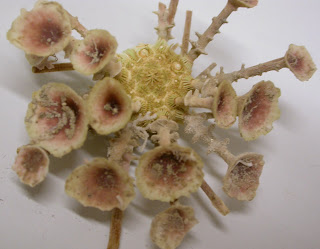 I am continuing my ongoing blogs from Paris for the next month or so, where I am working at the Museum national d'Histoire naturelle!
I am continuing my ongoing blogs from Paris for the next month or so, where I am working at the Museum national d'Histoire naturelle! When one thinks of Paris, one envisions all sorts of exotic and wonderous experiences- postcards, people, exotic burlesque shows, and food...
When one thinks of Paris, one envisions all sorts of exotic and wonderous experiences- postcards, people, exotic burlesque shows, and food... From the perspective of a biologist, the museum in Paris is EQUALLY exotic!
From the perspective of a biologist, the museum in Paris is EQUALLY exotic!Why? Because the Paris museum (the French equivalent to the Smithsonian's National Museum of Natural History) receives MANY specimens from exotic, deep-sea locales around the world.
Because I don't typically get access to many of these specimens, I thought I would share some choice samples from the collections with all of you..
How exotic are these?
Well, to start-I'm not entirely certain that everything I'm showing you below has actually been described in the scientific literature... MANY new species await discovery in the French vaults..

Goniocidaris from deep-sea habitats in the tropical Indo-Pacific..

The most obvious feature here being the bizarrely shaped spines that look like big inverted umbrellas!


Instead of the large spines ending in big flattened horn-thing, these spines are lance-shaped and have a progression of smaller and smaller spines and flanges..


What do the unusual spine shapes do? How are they adaptive? Defensive? Reproductive?
I wrote a blog about a similar cidaroid sea urchin called Psychocidaris. (click here to see!)
Here's a big, deep-sea sea urchin the size of a pumpkin called Echinus melo!
 Another large animal that we know practically nothing about...
Another large animal that we know practically nothing about... And finally, we end with one of the more exotic sand dollars.. a genus called Rotula from the African coast in the tropical Atlantic..
And finally, we end with one of the more exotic sand dollars.. a genus called Rotula from the African coast in the tropical Atlantic.. Weird are the many strange flanges and holes! What do they do?
Weird are the many strange flanges and holes! What do they do?Well, in other sand dollars they deflect the hydrodynamic flow.. Go here to see this explanation!
 and just for kicks..here's the bottom or ORAL SURFACE of one.. yes-even these weirdly shaped sand dollars have the tiny, "fur-like" spines covering them and with the channels that lead to the mouth...
and just for kicks..here's the bottom or ORAL SURFACE of one.. yes-even these weirdly shaped sand dollars have the tiny, "fur-like" spines covering them and with the channels that lead to the mouth... More next week...as Echinoblog in Paris continues!
More next week...as Echinoblog in Paris continues! 
7 comments:
Amazing pictures-- I didn't realize that sea urchins' spines could take on so many shapes.
To be sure, these are the extreme forms-but yeah-they are pretty amazing. I've gotten so used to knowing about them I keep on forgetting how little the public knows about them...
Cool creatures. There are still a lot of creatures waiting to be discovered in the depths of the see.
-admin
Thank you! This was the first place (after a fair amount of Googling) I could find an explanation for the 'fingers.' You're doing somethign useful! Thanks again!
By fingers-you mean the tiny gills that come off sea urchins and other echinoderms? That question comes up a lot..I'll have to write it up soon...
Thanks for the explanation on the sand dollars. I picked up hundreds of these while in Gabon but have never known what to call them or what the point of the fingers coming off them were.
Wow! Really? those are really cool animals. Great that you see so many of them! Keep track of where you get them. thanks for the info!
Post a Comment